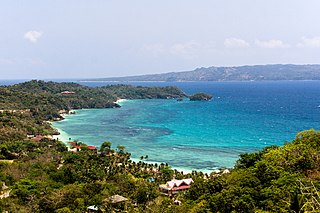
In the Philippines, provinces are one of its primary political and administrative divisions. There are 82 provinces at present, which are further subdivided into component cities and municipalities. The local government units in the National Capital Region, as well as independent cities, are independent of any provincial government. Each province is governed by an elected legislature called the Sangguniang Panlalawigan and an elected governor.

Romblon, officially the Province of Romblon, is an archipelagic province of the Philippines located in the Mimaropa region. Its main components include Romblon, Romblon, an archipelagic municipality of the same name that also serves as the provincial capital; Tablas, the largest island, covering nine municipalities; Sibuyan with its three towns; as well as the smaller island municipalities of Corcuera, Banton, Concepcion, San Jose. The province lies south of Marinduque and Quezon, east of Oriental Mindoro, north of Aklan and Capiz, and west of Masbate. According to the 2020 census, it has a total population of 308,985.

A city is one of the units of local government in the Philippines. All Philippine cities are chartered cities, whose existence as corporate and administrative entities is governed by their own specific municipal charters in addition to the Local Government Code of 1991, which specifies their administrative structure and powers. As of July 8, 2023, there are 149 cities.

Aklan, officially the Province of Aklan, is a province in the Western Visayas region of the Philippines. Its capital is Kalibo. The province is situated in the northwest portion of Panay Island, bordering Antique to the southwest, and Capiz to the southeast. Aklan faces the Sibuyan Sea and Romblon province to the north.

Capiz, officially the Province of Capiz, is a province in the Philippines located in the central section of Western Visayas region. Its capital is the city of Roxas. It is located at the northeastern portion of Panay Island, bordering Aklan to the north, Antique to the west, and Iloilo to the south. Capiz faces the Sibuyan Sea to the north.

Bacolod, officially the City of Bacolod, is a 1st class highly urbanized city in the region of Western Visayas, Philippines. It is the capital of the province of Negros Occidental, where it is geographically situated but governed administratively independent.

Public holidays in the Philippines are of two types: regular holidays and special non-working days.

Roxas, officially the City of Roxas, is a 3rd class component city and capital of the province of Capiz, Philippines. According to the 2020 census, it has a population of 179,292 people.

Ma-ayon, officially the Municipality of Ma-ayon, is a 3rd class municipality in the province of Capiz, Philippines. According to the 2020 census, it has a population of 41,226 people. It has a total land area of 142.32 km2 (54.95).

Tapaz, officially the Municipality of Tapaz, is a 1st class municipality in the province of Capiz, Philippines. According to the 2020 census, it has a population of 54,423 people.

Balasan, officially the Municipality of Balasan, is a 4th class municipality in the province of Iloilo, Philippines. According to the 2020 census, it has a population of 35,064 people.
The Aklanon people are the ethnolinguistic group who lived in the province of Aklan. They are part of the wider Bisaya ethnolinguistic group, who constitute the largest Filipino ethnolinguistic group.
CPDRC Dancing Inmates or the CPDRC dancers is a collective of prison inmates in Cebu Provincial Detention and Rehabilitation Center (CPDRC), a maximum security prison in Cebu, in Cebu Province, Philippines where the prisoners perform dance routines as part of their daily exercise and rehabilitation, and many of their performances are filmed and released online, making them a popular feature among fans and veritable online celebrities.
Jocelyn "Jocjoc" Isada Bolante is a Filipino politician who formerly served as an Undersecretary of the Department of Agriculture of the Philippines. He was implicated by the Philippine Senate to the ongoing investigation related to corruption concerning fertilizer funding while serving as a government official. Bolante left the Philippines on December 11, 2005. He returned to the Philippines on October 28, 2008, after being detained at an immigration office in the United States. The corruption related to fertilizer funds was exposed when news broke that a Filipino journalist, Marlene Garcia-Esperat, was killed on March 24, 2005.

The Seminary of St. Pius X, or St. Pius X Seminary (SPXS), is a Filipino Roman Catholic secondary school and seminary in the Lawaan hills, Roxas City, Capiz, in the Philippines, run by the Catholic priests of the Archdiocese of Capiz. The seminary and its surrounding areas comprise some three hectares of rocky hills. Cardinal Jaime Sin was the first rector of the school. In 1999, the college of St. Pius X Seminary transferred to Cagay, Roxas City, Capiz, and named the school Sancta Maria, Mater et Regina, Seminarium (SMMRS) to honor the Blessed Virgin Mary. SPXS decided to retain and maintain its high school and pre-college until 2012, pre-college was transferred to SMMRS.
"Awit sa Bohol", also known as the Bohol Hymn, is the official anthem of the province of Bohol in the Philippines.
"Sugbo", also known as the Sugbo Hymn, is the official hymn of the province of Cebu in the Philippines.
"Luyag Ko Tan Yaman", also known by its Filipino title "Pangasinan Aking Yaman", and generally referred to as the Pangasinan Hymn, is the official anthem of the province of Pangasinan in the Philippines.
The "Vizcaya Hymn" is the official anthem of the province of Nueva Vizcaya in the Philippines.

"Mabuhi!" ; cf. "mabuhay"), also known as "Mabuhi Ka, Sugbuanon", is a song written and composed by Filipino musician Paul Melendez. Often played and danced to at festivals throughout the province of Cebu, including at the Sinulog Festival, it is the signature song of the administration of Gwendolyn Garcia as the Governor of Cebu.













